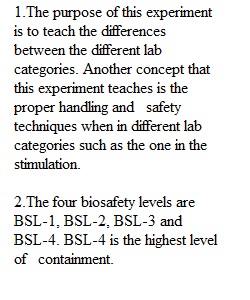


Q Required Resources: • Complete the Week Prelab Activity (Connect) Instructions Welcome to the (online) lab page. You should have already completed the Lab Safety virtual lab simulation on Labster. Here is where you will upload your completed lab document. Grading This activity will be graded using the rubric in the lab document. Course Outcomes (CO): 11 Due Date: By 11:59 p.m. MT on Sunday Lab 7: Biosafety Learning Outcomes • Explain how a biosafety containment level III laboratory is constructed (e.g. air flow and pressure control). • Explain the basic safety rules of a biosafety containment level III laboratory (e.g. use of safety equipment). • Handle microorganisms in a biosafety containment level III laboratory. • Explain the concept of fumigation and how this is executed within a microbiological safety cabinet. Introduction: Experiment with biosafety virtual simulation lab In the Biosafety simulation, you will be introduced to the concept of laboratory containment, which is a very special type of laboratory required to work with hazardous pathogens. Laboratory containment Containment in this context refers to the requirements set out by various bodies to safely manipulate such pathogens. In this simulation, you will be able to experience a containment level 3 (Biosafety Level 3 or BSL3) research laboratory. Learn about lab safety You will become familiar with the basic protocols utilized to ensure safety, and you will be presented with the specific basic safety rules for this type of laboratory (e.g. personal protective equipment (PPE) and primary containment). In addition, you will learn how every part of the laboratory is designed to avoid contamination. This includes learning about why the pressure in the laboratory needs to be controlled at all times (secondary containment), and how the microbiological safety cabinets are designed to offer protection). Identify the hazard In the biosafety simulation you will be presented with a hypothetical case where you will need to identify a potential bioterrorism agent that is classed as a hazard group three microorganism. Please note that this simulation has been developed broadly around UK regulations. Some protocols may differ depending on the specific regulations. Questions: 1. Purpose: Please describe in complete sentences and in your own words, the purpose of this experiment. 2. What are the different biosafety levels? 3. What practices would you recommend to be used in BSL 1 and how do these differ from BSL 2? 4. In this simulation what organism was discussed? Which biosafety level is this pathogen handled in? Why? 5. What does biosafety level 4 mean? What type of pathogens can only be handled in these labs?
View Related Questions